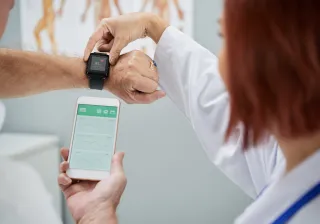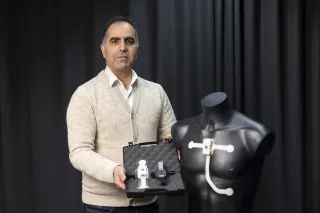The ageing population in Finland needs more high-quality care services. We are facing a future nurse shortage: nearly a third of practical and registered nurses will retire by 2030. The development of robotics will help bridge the gap.
Care services need new solutions that are humanely and economically sustainable and support the well-being and independent living of the ageing population. Care staff need tools that reduce urgency and physical strain – to make room for departing from routines and having time for encountering customers. It's about making everyday life easier.
Robotics has a significant growth potential in the health sector. The most interesting applications include robots developed for diagnostics, remote connections and delivering and dispensing medication, and autonomous vehicles and social companion robots . In these applications, the technology is reasonably mature and international actors are looking for new partners. When we build solutions on Finnish technological expertise, we are creating opportunities for companies.
Involving care staff in development work
The health care service system is a particular environment with strict rules – a robot can't just saunter in. The technology must be absolutely mature, easy to use and safe. Having a grasp on the regulations concerning medical devices is also important. A robot must be designed as part of the health service and the related information systems.
Professionals have to be given the opportunity to try out the solutions and see their benefits.
Safety and reliability are highlighted when customers are in a vulnerable position. Care staff are intimately familiar with the requirements of their work – that's why the implementation and introduction of new equipment must be planned together with them. Professionals have to be given the opportunity to try out the solutions and see their benefits.
But the toughest pill to swallow will probably be the price point of robotics. People may be interested in investing in robotics, but they need to see positive impacts on welfare, personnel and costs. This requires sufficient piloting. By supporting technological development, the prices of components and robots will come down. The different areas of robotics are developing constantly and robots are becoming more operationally stable, which makes longer-term pilots possible. By supporting robotics acquisitions, we will be able to assess the effectiveness of more expensive robots.
Support from research, new direction from platform thinking
Companies are not alone in this matter. The Ministry of Social Affairs and Health has launched the Technology supporting smart ageing and care at home programme (KATI) to promote the adoption of new solutions in the services for older people. The programme encourages renewing home services with the help of technology and highlights the importance of impact assessment. VTT is guiding and monitoring the progress of how these technologies are utilised. Hopefully KATI will produce new robots that support older people living at home!
Platform thinking brings new alternatives to the development of robotics in the health sector. The applications of robotics are still narrow, and intelligent multi-purpose robots are still technologically unattainable. In VTT's MURO concept, the issue has been resolved by having one robot platform offer a wide range of services but directing the functions separately. Platform thinking has been extended all the way to business: any customer can buy capacity from a robot and integrate it in their service. The customer doesn’t have to invest in the acquisition of a robot; instead, the market will have robot operators offering services that are priced by task. For example, at a health centre, the same MURO robot can direct a customer to the right waiting room, transport supplies to a nurse, notify the cleaning service of a dirty floor or describe the progress of a corridor renovation to facility services.
Interaction brings robots from industry to services
The big thing about robotics in the future – I think – will be natural interaction between robots and humans. We humans are fascinated by the possibility of developing robots that are like us, and using robots will be made easier with the kind of interaction that comes naturally to us. Interaction extends the possibilities of using robots from industry to services. I recommend keeping an eye on the development of conversational AI.
Robotics can also be used to understand human behaviour. VTT and a corporate consortium created a vision of a platform solution based on the identification of biosignals and micromovements that could produce information on people's emotional state through fixed and robot sensors . Emotional data gathered from the environment would help improve services or guide the robot to work with people in a smarter way.
Time for action in the health sector
The health sector needs robotics, and we want to support companies’ development work with research and by encouraging the customers to participate in co-design and to adopt new products. New business models can be developed in cooperation. Technology will be an essential part of high-quality and sustainable welfare services. We hope that companies will join the development of robots right now.






